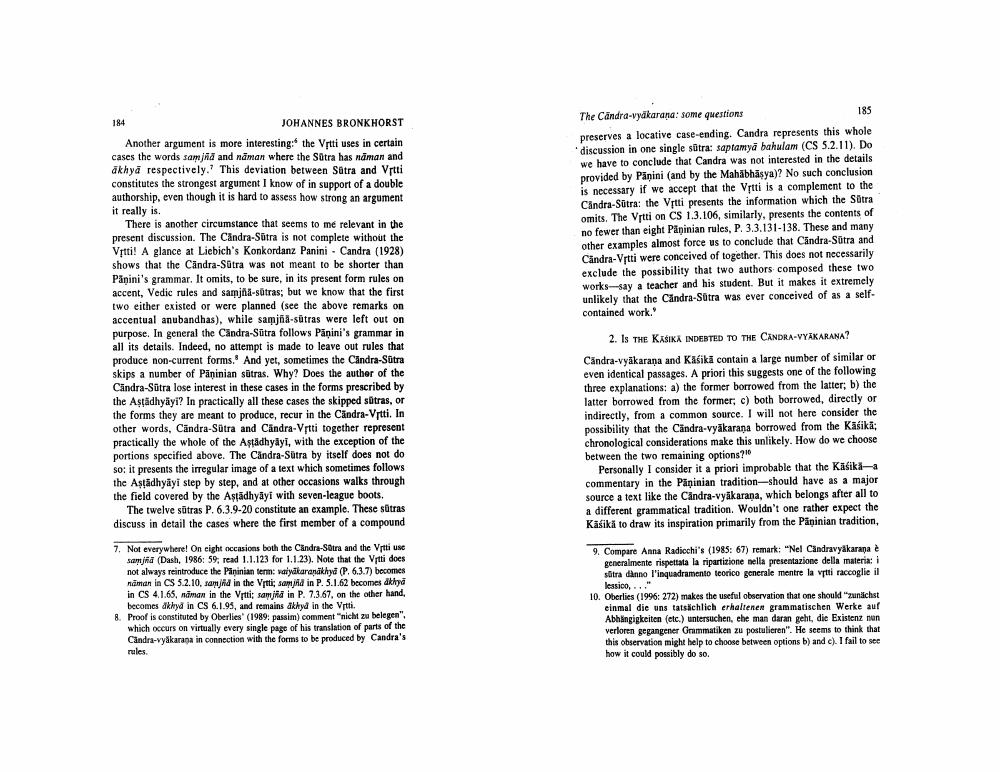Book Title: Candra Vyakarna Some Questions Author(s): Johannes Bronkhorst Publisher: Johannes Bronkhorst View full book textPage 2
________________ The Candra-vydkarand: some questions preserves a locative case-ending. Candra represents this whole discussion in one single stra: saptamya bahalam (CS 5.2.11). Do we have to conclude that Candra was not interested in the details provided by Panini (and by the Mahabhasya)? No such conclusion is necessary if we accept that the Vrtti is a complement to the Candra-Sutra: the Vrtti presents the information which the Sutra omits. The Vrtti on CS 1.3.106, similarly, presents the contents of no fewer than eight Papinian rules, P. 3.3.131-138. These and many other examples almost force us to conclude that Candra-Sutra and Candra-Vrtti were conceived of together. This does not necessarily exclude the possibility that two authors composed these two works-say a teacher and his student. But it makes it extremely unlikely that the Candra-Sotra was ever conceived of as a selfcontained work." JOHANNES BRONKHORST Another argument is more interesting the Vrtti uses in certain cases the words sam jria and naman where the Stra has naman and akhyā respectively. This deviation between Sätra and Vrtti constitutes the strongest argument I know of in support of a double authorship, even though it is hard to assess how strong an argument it really is. There is another circumstance that seems to me relevant in the present discussion. The Candra-Sütra is not complete without the Vitti! A glance at Licbich's Konkordanz Panini. Candra (1928) shows that the Candra-Stra was not meant to be shorter than Panini's grammar. It omits, to be sure, in its present form rules on accent, Vedic rules and samjha-stras; but we know that the first two either existed or were planned (see the above remarks on accentual anubandhas), while samjhi-stras were left out on purpose. In general the Candra-Sutra follows Panini's grammar in all its details. Indeed, no attempt is made to leave out rules that produce non-current forms. And yet, sometimes the Candra-Sutra skips a number of Paninian sutras. Why? Does the author of the Candra-Sätra lose interest in these cases in the forms prescribed by the Astädhyayi? In practically all these cases the skipped stras, or the forms they are meant to produce, recur in the Candra-Vrtti. In other words, Candra-Sotra and Candra-Vrtti together represent practically the whole of the Astadhyayi, with the exception of the portions specified above. The Candra-Sutra by itself does not do so: it presents the irregular image of a text which sometimes follows the Astādhyayi step by step, and at other occasions walks through the field covered by the Astādhyayi with seven-league boots The twelve stras P. 6.3.9-20 constitute an example. These stras discuss in detail the cases where the first member of a compound 2. Is THE KASIKA INDEBTED TO THE CANDRA-VYAKARANA? Candra-vyakarana and Kasiki contain a large number of similar or even identical passages. A priori this suggests one of the following three explanations: a) the former borrowed from the latter; b) the latter borrowed from the former; c) both borrowed, directly or indirectly, from a common source. I will not here consider the possibility that the Candra-vyakarana borrowed from the Kasika: chronological considerations make this unlikely. How do we choose between the two remaining options? Personally I consider it a priori improbable that the Kasika commentary in the Paninian tradition should have as a major source a text like the Candra-vyakarana, which belongs after all to a different grammatical tradition. Wouldn't one rather expect the Käsiki to draw its inspiration primarily from the Paninian tradition, 7. Not everywhere! On eight casions both the Candra-Seurs and the Vise samjha (Dash, 1986:59, read 1.1.123 for 1.1.23). Note that the Vitti does not always reintroduce the Paninian term valytarankhyd (P. 6.3.7) becomes naman in CS 5.2.10, mjid in the Vitti, samjid in P. 3.1.62 becomes dikya in CS 4.1.65, man in the Vytti; samjid in P. 73.67, on the other hand, becomes dyd in CS 6.1.95, and remains akhyd in the Vrtti. 8. Proof is constituted by Oberlies' (1989: passim comment nicht belegen". which occurs on virtually every single page of his translation of parts of the Candra-vyakarana in connection with the forms to be produced by Candra's 9. Compare Anna Radicchi's (1985: 67) remark: "Nel Candravykarana è generalmente rispettata la ripartizione nella presentazione della materia: i sitra danno l'inquadramento teorico generale mentre la vrti raccoglie il lessico,..." 10. Oberlies (1996: 272) makes the useful observation that one should unlichst einmal die uns tatsachlich erhaltenen grammatischen Werke auf Abhingigkeiten (etc.) untersuchen, the man daran geht, die Existenz nun verloren gegangener Grammatike u postulieren". He seems to think that this observation might help to choose between options b) and c). I fail to see how it could possibly do so.Page Navigation
1 2 3 4 5 6 7 8 9 10
